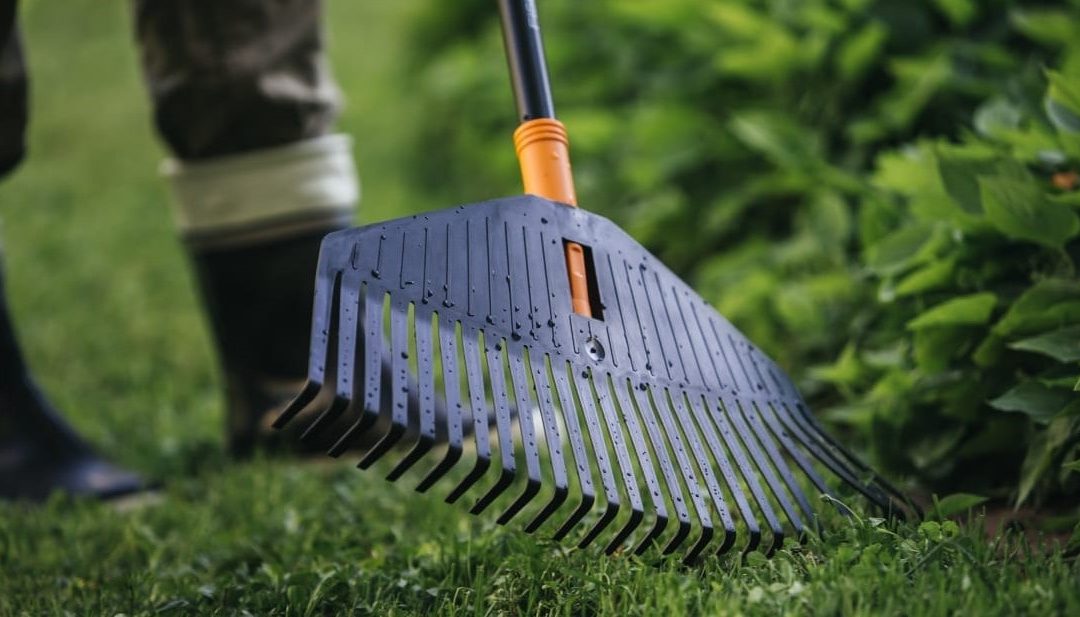Gardening tools are indispensable assistants for every gardenowner. These equipments greatly facilitate the hard work of gardeners. For many decades, the most popular equipment has been garden rakes.
This tool is a reliable assistant not only in cultivating the land, but also in collecting hay and berries, and in caring for the lawn and decorative flower beds.
Before going to a specialized store, you need to know exactly what type of work the purchase is intended for. Modern manufacturers produce a huge range of products that will surprise even the most experienced homeowners. The purchased product must have all quality certificates and permits.
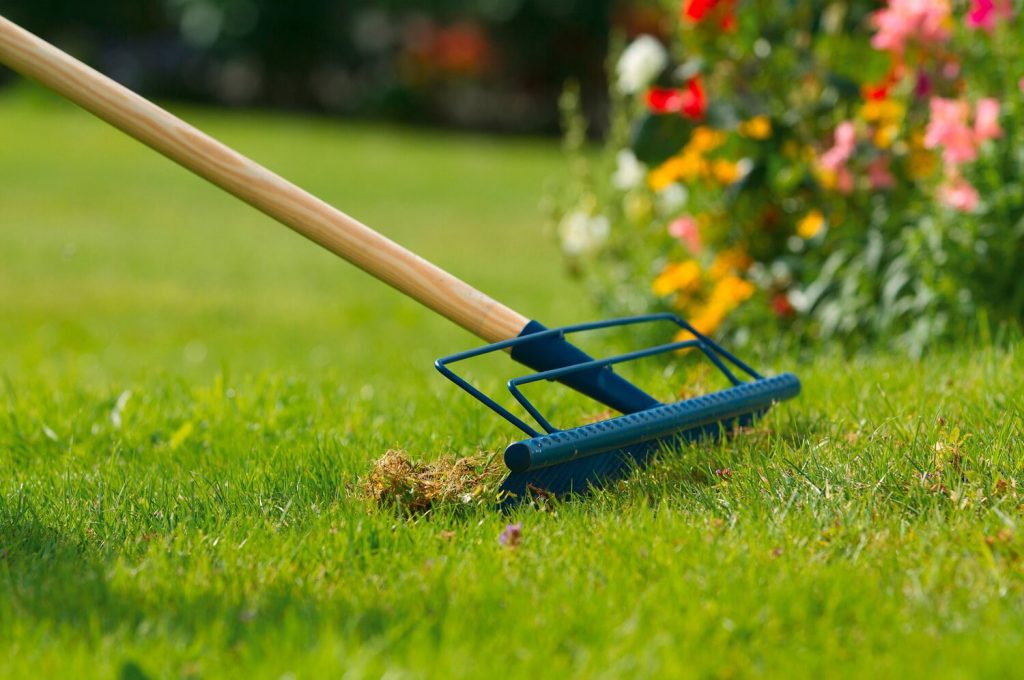
A garden rake is the most multi-functional tool in the garden. It can be used to loosen, break clods of earth, remove leaves and debris, revitalize the lawn, and do many other things. But each task requires a special rake.
On the store counter, you can see many rakes of various configurations, materials, and colors. Their prices also vary significantly, which can confuse a novice gardener. You should choose a garden rake depending on what kind of work you are going to do with it, but there are some general requirements for this garden tool.
Table of Contents
Garden Rake Types
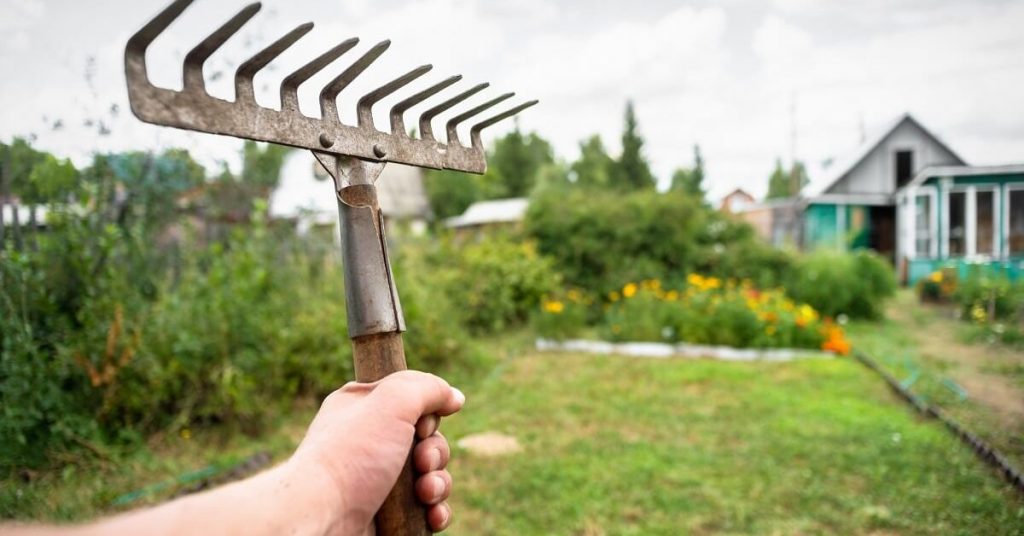
For many hundreds of years, people have been using garden tools to perform agricultural work. Innovative technologies and modern equipment have enabled manufacturers not only to improve simple tools but also to develop new designs and improve their functions.
This trend has affected not only complex devices but also simple ones such as garden rakes. On the shelves of specialized stores, you can see a huge number of these tools, which differ not only in price, the material of manufacture, and manufacturer, but also in functional purpose.
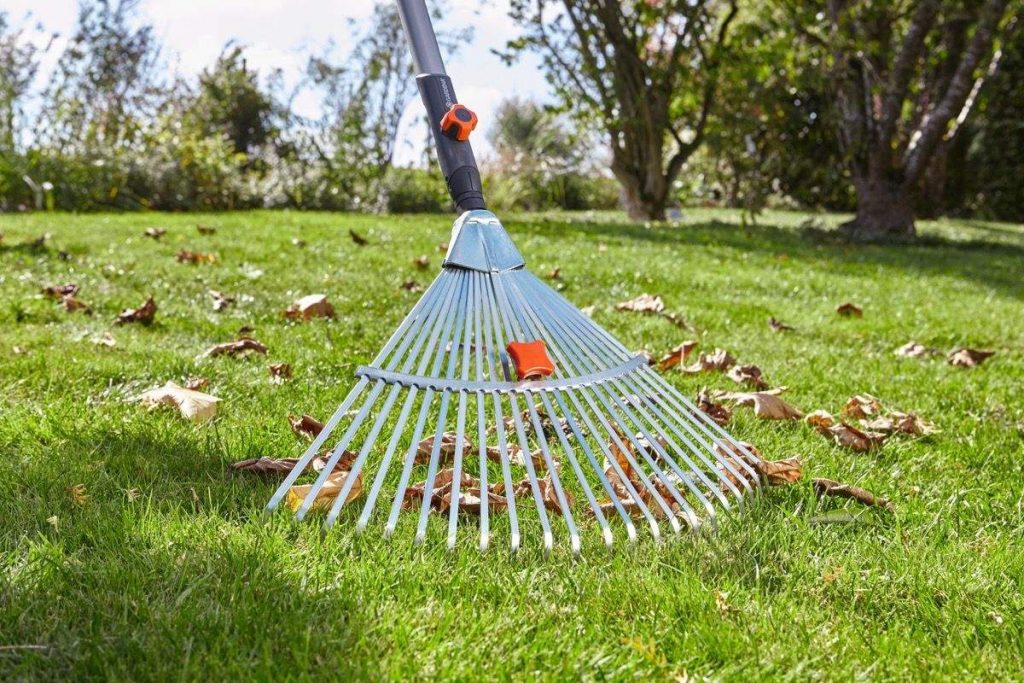
Before going to the store, novice gardeners should study all the design features of each model, and experienced consultants will certainly help them make the right choice and purchase the right garden tool.
Let’s explore the diverse world of garden rakes available in the market, and learn what key types and features to check for in each type.
Straight Rake

A classic model that can be used to do almost everything in the garden. Such rakes with metal teeth are used to loosen and level the soil, and wooden ones, are used to clear mown grass and leaves from the area.
The teeth of such a metal garden rake can be straight or slightly curved inward – this will not affect the final result.
Rake With Twisted Teeth

A practical analog of the previous model is a garden rake with twisted teeth. These metal teeth are rotated 180 degrees at the base and are pointed.
They effectively loosen the soil, break up even compacted clods, and allow you to significantly speed up the preparation of beds for planting.
Rake Aerator

Although it is customary to remove debris and dry grass from the lawn with a fan rake, a harsh-looking aerator rake will be much more useful. They look like straight ones, but the teeth are shaped like a sickle and pointed downward.
Thanks to this shape, they not only collect debris, but also clean moss from the lawn, and also make small (up to 3 cm) slits in the turf through which air, water, and nutrients flow to the roots.
Lawn Rake

If you have a large lawn and a mower without collecting grass clippings, you often move large volumes of hay around the area, raking it into piles.
A clever lawn rake will come to your rescue. They have thin and frequent teeth that do not miss a single blade of grass, and an additional limiting frame that allows you to move plant debris around the area and not be afraid that it will spill out from the end of the rake.
Fan Rake

This model can be equipped with plate or wire teeth and made of metal or light plastic. Their working part is always in the shape of the letter V, and the first option is tougher and allows you to properly “comb” and thin out the lawn, while the second, on the contrary, will protect it from damage and collect only excess debris.
In areas with tall grass, it is better to use garden rakes with springy plastic teeth, but in short vegetation, their wire counterparts will not get tangled or make holes.
Discover the convenience of this new generation of Adjustable Fan Garden Rakes – a must-have for versatile gardening!
Mini Garden Rake
Narrow (with a working part width of no more than 20 cm), with a short handle, mini-rakes are designed for working in the most inaccessible corners of the garden.
In the fall, they are great for raking leaves from under ornamental shrubs, clearing weeds from the soil at the base of a hedge, or loosening a flower garden.
Of course, large mounds of earth cannot be broken up with this tool, but it is better suited for “jewelry” gardening than others.
Milling Rake

Double-sided milling rakes are still a novelty for our summer residents, but they not only have two sides but also two methods of use.
The side with more frequent teeth can be used to remove debris and stones from the area, level mulch on paths, or break up earthen clods and heaps. But the side with crescent-shaped teeth should be used like a regular aerator rake, i.e. clean and refresh the lawn.
How to Choose a Garden Rake?
Modern manufacturers produce garden rakes for various purposes: for cleaning leaves and asphalt, for the lawn and for collecting hay, for working with the soil, and for picking berries.
Before going to the store, novice gardeners must know the rules for choosing a tool. Experienced gardeners note several signs of a good tool.
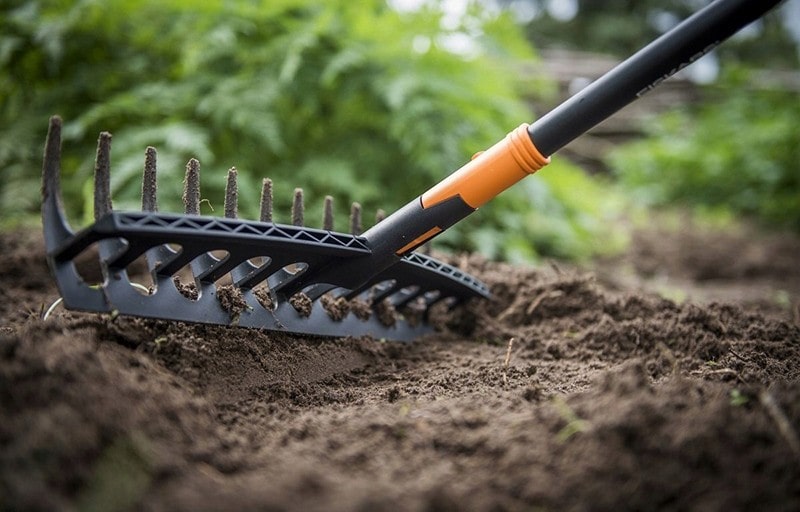
Expert’s Recommendations for Selection
- The length of the garden rake should reach the shoulder of the working person. Experts recommend paying attention to a tool with a retractable handle, the length of which can be changed depending on the situation. The number of elbows in the handle depends on the model and purpose of the tool.
- The width of a standard tool should not exceed 50 cm. To perform excavation work, preference should be given to a tool whose width is no more than 20 cm. For harvesting dry grass and light leaves, you can purchase a garden rake with a width of 75 cm.
- The thin metal on the transverse part of the instrument is a sign of low price and fragility. Manufacturers recommend purchasing tools made of hardened and reinforced steel with an anti-corrosion coating.
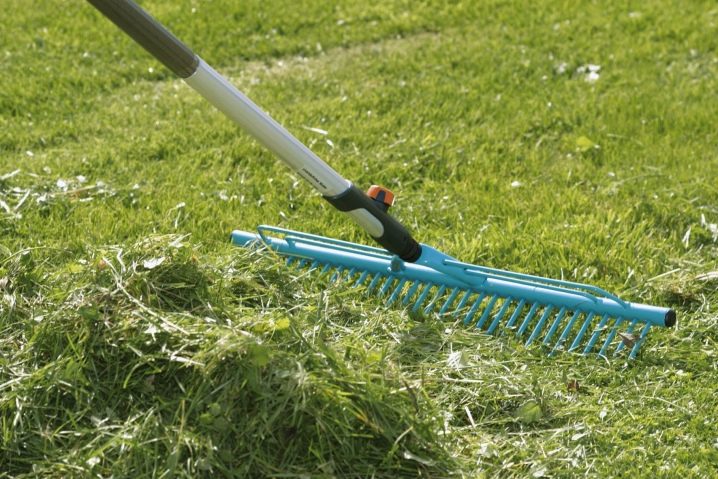
- The most convenient are handles with rubber inserts that will prevent your hands from sliding on the surface. A prerequisite is the absence of cracks, defects, knots, and play in the fastening area.
- A convenient part of the tool will be an English D-shaped handle located at the end or in the center of the handle.
- The presence of quality certificates and permits is a guarantee of purchasing a safe and durable product.
- The working width depends on the area of the treated area.
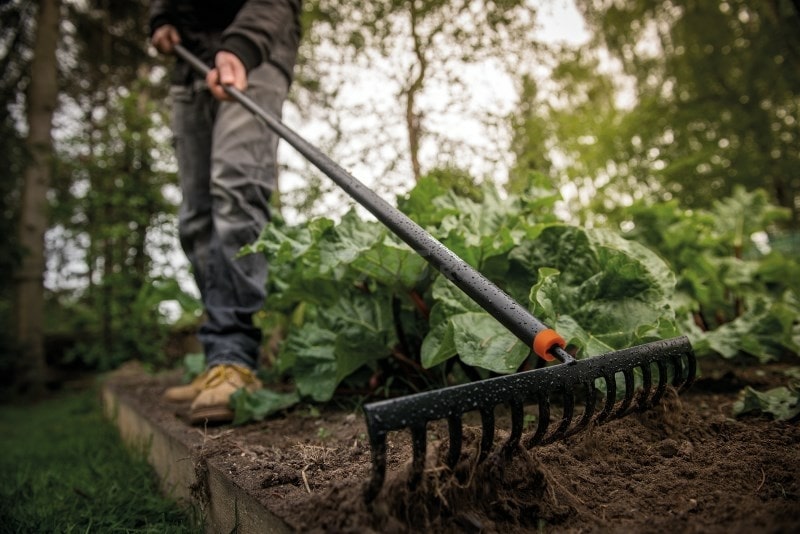
The main criterion that influences the purchase of the right type of garden rake is its purpose. To work with the soil, you need to choose a metal tool, to remove light and dry debris – a plastic garden rake, to collect berries, the tool must have a narrow grip and flat teeth, even lawn tools have many individual features.
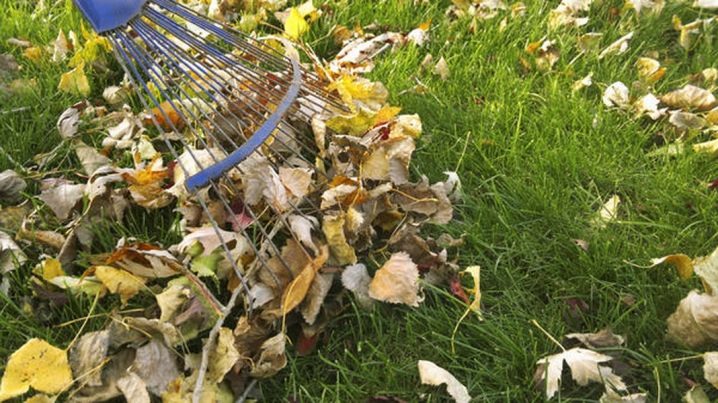
Experienced gardeners advise purchasing universal garden rakes, which come with additional attachments. Before purchasing, you need to check the reliability of fixation of each attachment to the handle.
To reduce physical exertion in the process of collecting hay or dry leaves, you need to opt for a mechanical garden rake, which has the shape of a regular one but moves with the help of wheels.
The design of this device is very simple and consists of a rectangular nozzle, two wheels, a square pipe, a stud, and a nut. To assemble a mechanical rake, you need a minimum number of tools and basic knowledge of mechanics.
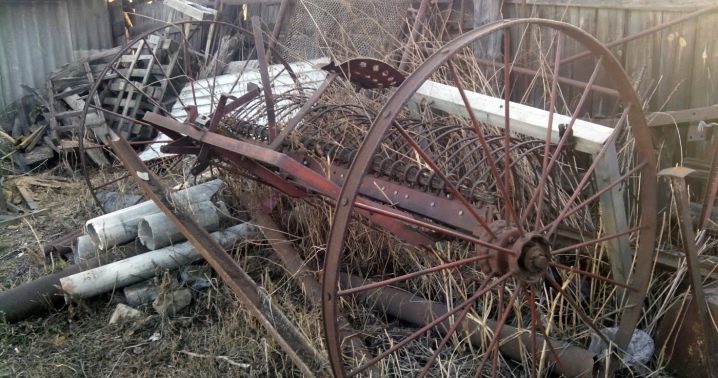
Now that you’re armed with knowledge on choosing the perfect garden rake, why not make your purchase even easier? Explore our curated list of the best garden rakes, carefully selected for quality and efficiency.
Conclusion
Remember! Don’t go after a cheap garden rake – an unnamed manufacturer, low-quality material, and a thin plastic handle will certainly not only make the tool cheaper but also shorten its service life several times.
For an extensive collection of gardening tools, explore “The Best Gardening Tools in 2024: An Ultimate Guide & Checklist.”

